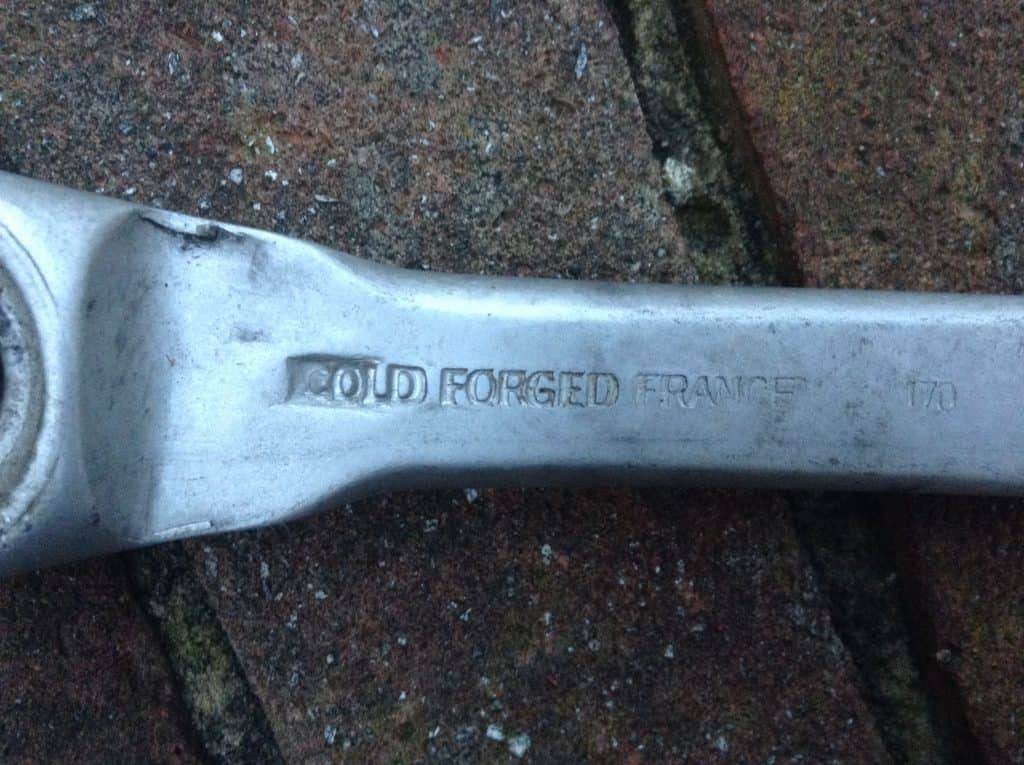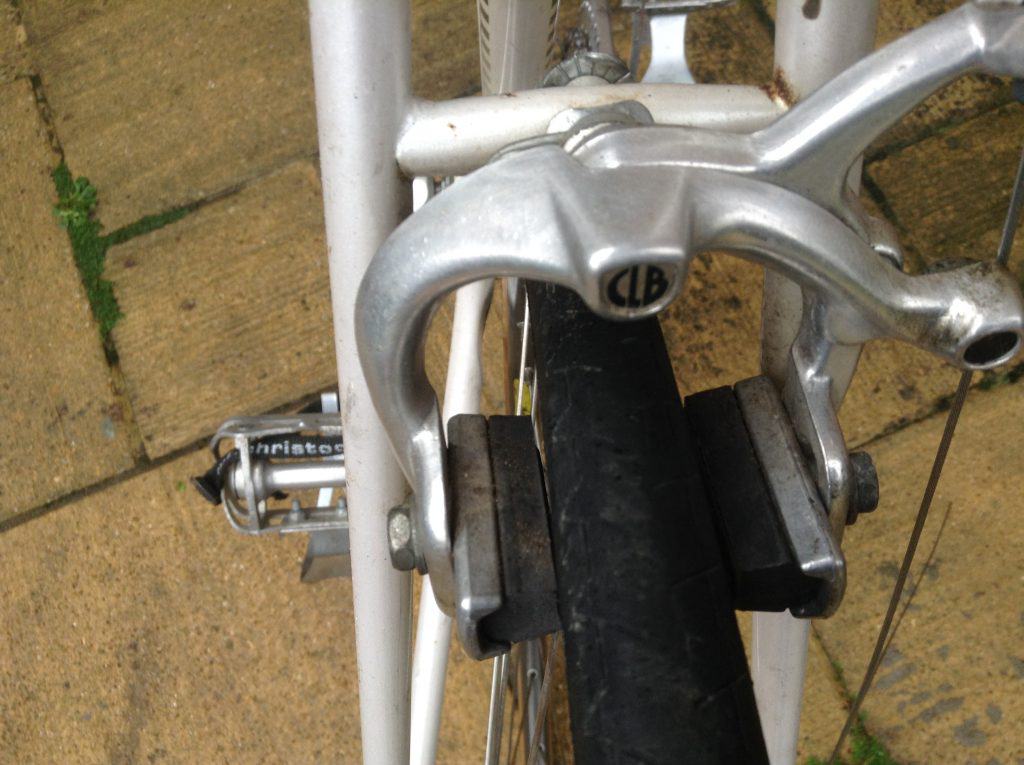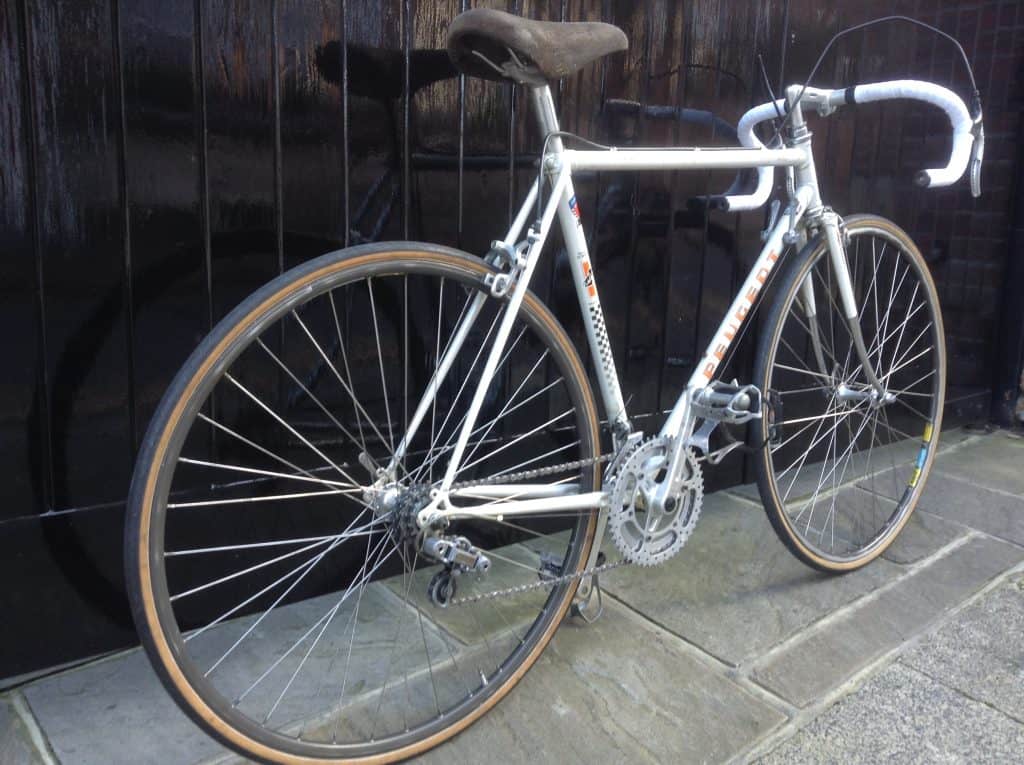The Earlier, the Better
It’s well known that identifying Peugeot models can be very confusing, so at least this bike had its name written on the top tube: Course. In French it means “race”, equivalent to the British term for a road bike of the vintage era. Modern road bikes are called velo route in France, and the Peugeot Course was a popular and frequent road bike model in the brand’s catalogues of the 1980’s. Many of these Course models were just bread and butter bikes, especially as the ’80s progressed. Some had Carbolite tubing and pretty basic components. This earlier bike, however, is a different specimen; being from 1981, it is made with Vitus 181 tubing. It’s exact title was a PFN 10.
Looks Can Be Deceiving
When I bought this bike, I gave it a quick look over and it seemed in decent shape, mostly needing a good clean and basic tune up. Well, let me tell you, I was wrong on that count. It was one of those deceptive bikes that needs a lot more work than you think, with issues that lurk beneath the pretty impression it gives. But after a good look at it once home, I decided I didn’t like the saddle, the dreary tape, and obviously the front derailleur was missing. The frame seemed in decent shape, though it was by no means glimmering in the autumn sunshine. I’d give it 7/10, as the chrome seemed to have survived quite unscathed. Unfortunately, there was some touch up paint on the top tube, and that clear coat which lends the shimmer to the pearlescent white of these Peugeots was mostly worn away.
Surprises and Befuddlements
The first thing I normally start with when restoring is removing and cleaning the crankset. This one was a three armed Stronglight, and guess what? I hadn’t noticed the crank arms weren’t matched. Yes, it was not until I looked more closely that I saw the left arm was a replacement. What is it? I have no idea. It has no markings on it except a “Made in France” stamp, but by golly, its ugly. It’s definitely a newer crank arm with it’s curved shape and allen bolt attachment, but strangely, it has French threads: 14 x 1.25. That’s weird, don’t you think??
Necessary Replacements
I swapped out that ugly left side crank with a nicer Solida arm, same threading, better looking ( though with the drilled dust cap! ). I didn’t have an extra matching Stronglight arm lying about, so it was the best I could do without replacing the whole crankset. Another necessary replacement was the rear Weinmann 506 caliper. It had been through the ringer and had lost both its centre bolt cap as well as its cable bolt. The cable itself had frayed into a form of wire spaghetti and I began to realise that this bike had been ridden into a poor and completely unroadworthy condition. Luckily, I had a CLB caliper to replace it, and incredibly, it had good spring tension. So now the bike was gathering spares: the crank arm and the caliper. But my luck was about to change.
The Winged Wheel
I had no idea the identity of these hubs on this bike when I rushed through the sale. I just really like these Vitus framed Peugeots and I wasn’t hanging about with the seller. The hubs were covered in dust, so thick that they could have been any brand, to be honest. The Mavic Open CD clincher rims and Michelin tyres suggested, however, that this was a quality wheelset. I took some fine steel wool and just used soap and water to begin cleaning the hubs, and from out of all that dirt and dust came what every restorer yearns to find: the winged wheel of a Campagnolo logo. These hubs are of such good quality that in no time they began to sparkle back into life, rejuvenated from their long prison of grime. With a bit of polishing they looked superb, regal, shining like they had been hardly used.
Some Detective Work
A 6 speed Sachs freewheel, caked in hard road dirt, gave me the date of these pair of lovely wheels: 1983, stamped on its rear. I removed the freewheel and cleaned it, ( it takes a Park Tool two pronged freewheel removal tool to release it ), which also enabled me to adjust the rear hub which was as so loose it rattled. The front hub was in the same condition, making these wheels basically unrideable when I bought the bike. So, building together a history here, these wheels were built 2 years after this bike was purchased: I’m guessing the owner rode the bike regularly, as a change of wheels and crank arm points to extensive use, backed up by the worn paint and shot rear brake. He certainly didn’t trash it; the touched-up paint shows a certain level of care and attention given to his ride, but eventually this Peugeot was ridden until it was abandoned to the shed by the once proud owner. So that’s my my Sherlock Holmes surmising on this one!
The Repairs
Here is a list of repairs this bike needed, which took about a couple of days to complete:
- Crankset clean and left arm replacement
- Rear brake caliper replacement
- New rear brake cable fitted
- Front brake lubricated, centred and adjusted
- Headset cleaned and regreased
- Hubs adjusted, cleaned
- Freewheel removed and cleaned
- Front derailleur fitted, adjusted
- Chain cleaned
- Bottom bracket adjusted
- Rear derailleur jockey wheels cleaned
- Gears tuned
- Saddle and post replaced
- Handlebar grip replaced
- Stem removed and refitted
- Pedals cleaned ( can’t be adjusted )
- Frame cleaned and polished
Completion, Dating and Specs
Under the bottom bracket is a serial number beginning with 14.., as well as the model name, PFN 10. I dated it to 1981, since the Atom pedals are stamped with that year, and the bike matches the PFN 10s of 1981 in the old catalogues of French sold Peugeot bikes. I believe the 1982/83 PFN 10s had a plainer seat tube, and were built with Vitus 172 tubing. The wheels, as mentioned, are not original, and were added later as an upgrade. The bike is light and is a good ride, though it is too small for me, but I always like the way these Vitus framed Peugeots roll. After some polishing, the tubes shined up more, the downtube being the best, still retaining some of its original shimmer. Yes, there are quite a lot of scratches and chipping on the tubes of this bike, but it’s still a wonderful bike to look at and own. I hope it lasts another 36 years, at least.
- 1981 Peugeot Course PFN 10
- Vitus 181 Main Tubes
- Chromed Fork Crowns and Half Chrome Forks
- Simplex Dropouts
- Litespeed French Threaded Headset
- Unbranded French Threaded Bottom Bracket
- Philippe Professional Stem
- Stronglight TS/ Solida Crankset, 52/42
- Simplex SX410 Rear Derailleur
- Shimano 600 Front Derailleur
- Simplex Criterium Shifters
- Mavic Open CD Anodised Clincher Rims
- Campagnolo Triomphe Hubs, British Threaded
- Sachs 6 Speed Freewheel, 14-20
- Weinmann 506/CLB Brake Calipers
- Mafac Brake Levers
- Italia Sprint Suede Saddle
- SR Seatpost, 26.4mm
- Atom Pedals, Christophe Clips and Straps
- Michelin 700 x 23 Clincher Tyres
- Weight: Full Bike, 21.8lbs
















I think you will find the Course to be a very enjoyable bike. I owned a Canadian built Peugeot PF 40 back in the early 80s with the same 181 frame and Carbolite fork but built as a randonneur bike with wiring, generator, lights and fenders. I currently am restoring a Canadian built 1982 Course PB 12 which you might find of some interest.
https://peugeotcoursepb12.wordpress.com/
I bought this same exact bike a little over a year ago. I love old roadbikes, so I was stoked to pick up an oldie (but a goodie) for $70 and then fix it up a bit. It has by far been my favorite. (not to mention how sexy it is)
Hi there! are all the parts original except for the wheels?
I am restoring the same exact bike and i am having trouble trying to find the original specs!
Thank you!
Yes, most parts are original to the bike. I think the original wheels would have been Atom Helicomatic small flange hubs laced to Mavic Module E clincher rims. Good luck with your restoration!
I have purchased an original specs one today which is 181, maillard hubs and pedals, simplex gearing basged Peugeot and screw on front mech rather than band on, atax bars/stem and Weinmann break levers and callipers.
Hi, I have similiar and identic frame set with yours. But the decals are gone. Can you show me the catalogue of this bike? I search the catalogue but I can’t find the similiar one (the fork mostly different with us). 🙂
Thank you.
Mirza from Indonesia
Can you tell me what type of replacement tire do you use on a vintage Peugot with Rigida 27 x 1 1/4
?
Hi, yours is a 27 inch rim, so you just need a 27 x 1 1/4 tyre, which was a common size on vintage rims in the 1970’s. They should be quite cheap and you can find them in many shops or online.
l used to own a Vitus181 tubed PFN10,the blue one’.I owned this bike for 26yrs,until it ‘went missing’.I have been after another for the past six years,and have almost given up.Can anybody help? Please note I am only interested in a immaculate condition example,( I know there still out there).52cm to 54cm please.
If you want to identify which Peugeot bike model belongs to, locate its serial number on the underside of the bike’s lower frame. We can begin to identify Peugeot bicycle models from the 1920s. The leading bike model introduced in this decade was the Peugeot P-10. Peugeot used six digits to mark its bikes released in the 1950s and 1960s, some even having seven digits in the late 1970s. As for 1980s bicycles, they have eight digits and an alphanumeric prefix in the serial number. Models introduced in the 50s had PC-10, PH-10, and PLX-10 in their serial numbers.
Many cyclists who own Peugeot bike’s vintage models, want to identify which Peugeot model they have. In this way, they can determine the material used, and the specifications the bike has.
Very interesting to read about the “unknown” made in France left crank arm.
I own an almost identical Peugeot Course made from Vitus 172.
Mine had the identical, not matching, left arm that looked like to be a complete mismatch. Now after reading your post, I have to guess that they were stock, despite not matching?
Unfortunately, the original fork broke, so had to replace with one that does not match 100%. Still looking for the half chrome fork
That’s a beauty, thanks for sharing. It’s bizarre to hear that yours had the same mismatched crank arm, perhaps they were low on stock at times and just used these unbranded replacements. If I ever come across the correct fork I’ll let you know, but your replacement fork does a good job. Cheers!
I have a ALL Original one. I just put new tires and tubes tuned up. Looking to sell it. Whats the value of Course? Thank you for any help.